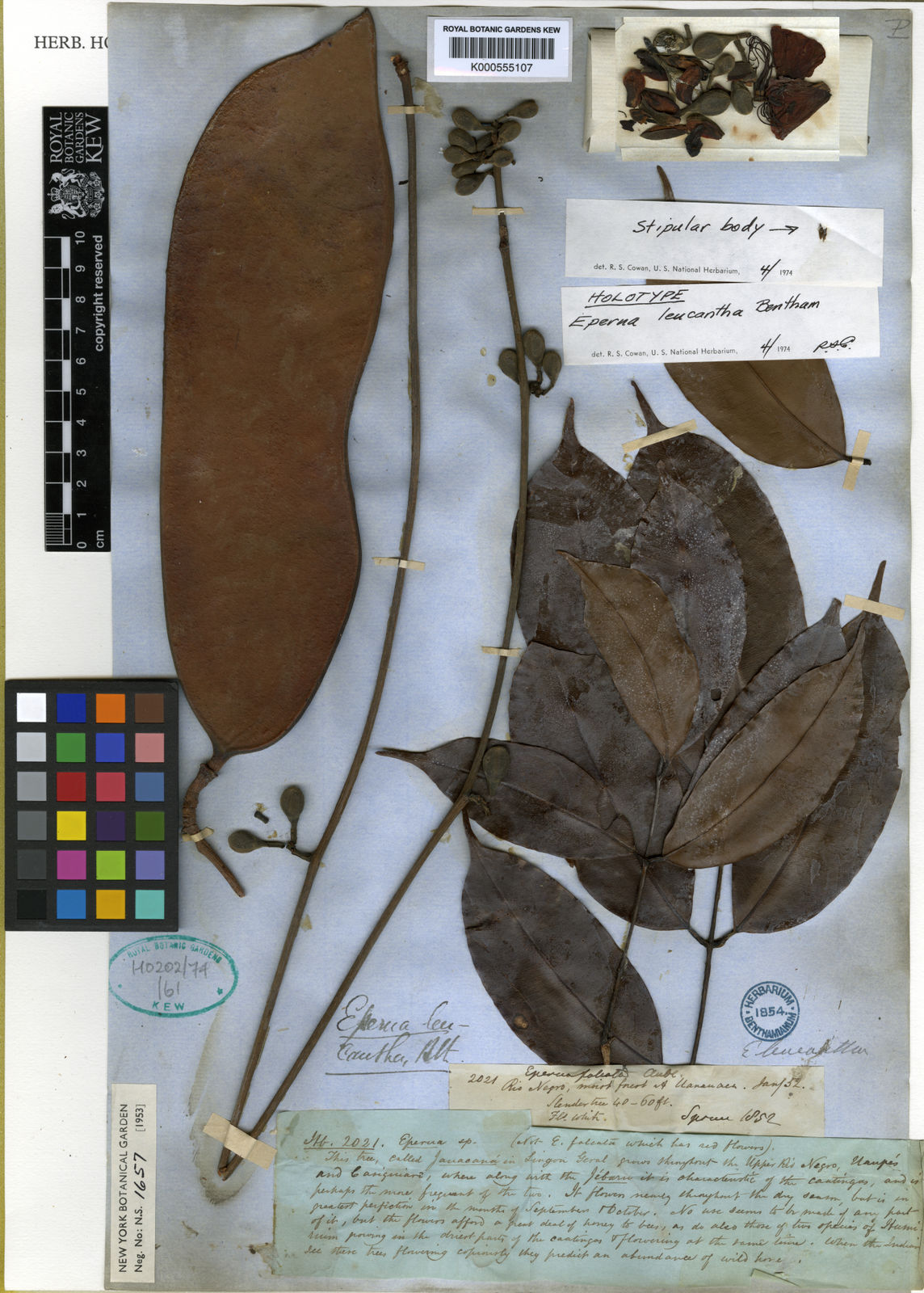White Angelim
eperua falcata
Also known as: ["Angelim Branco","White Angelim"]
Overview
A large tropical tree native to South America, valued for its hard, durable wood and ecological significance in rainforest ecosystems.
Benefits & Perks
["disease resistant","wildlife attractant (bees, butterflies, birds)","shade tolerant","rare/collector’s item"]
Botanical Classification
| Phylum: | Magnoliophyta |
| Class: | Magnoliopsida |
| Order: | Fabales |
| Family: | Fabaceae |
| Genus: | Eperua |
| Botanical Name: | Eperua falcata |
Plant Characteristics
Basic Information
- Category: Trees
- Suitable Location: tropical or subtropical garden, sheltered from strong winds
- Suitable For:
- Is Weed: No
- Allergenicity: low
Environmental Needs
- Climate: {"temperatureRange":"18–30°C"}
- Hardiness: {"zones":"9–11"}
- Misting: rarely required, only if ambient humidity is very low
- Drainage: Fast-draining to prevent waterlogging.
- Soil Type: Well-draining, fertile soil mix with organic matter; cactus or succulent mix amended with compost works well.
Maintenance Level
- Maintenance Level: very high
- Toughness Level: very high
- Pruning Frequency: Annually or as needed to control size and shape; light pruning can be done throughout the growing season.
- Pruning Intensity: Moderate; remove up to one-third of growth if necessary, but avoid heavy pruning unless required.
Care Details
Ideal Sunlight Coverage:
Bright indirect light for 6–8 hours daily; tolerates partial shade but may require acclimation to direct sun.
Sunlight Tolerance Tips:
Gradually introduce to direct sunlight to avoid scorching; place in filtered light outdoors; rotate regularly for even growth.
Care Requirements
Care Difficulty
expert onlymoderate
Sunlight
partial shade to full sun with protection from intense afternoon sun
Avoid direct midday sun; provide dappled light in hot climates; adjust light exposure seasonally.
Watering
every 7–10 days during active growth, reduce in winter
Water thoroughly until it drains from the bottom; allow soil to dry between waterings; avoid overwatering.
Soil
well-draining, loamy soil with organic matter
pH: Slightly acidic to neutral (pH 6.0–7.0).
Avoid heavy clay soils; ensure pots have drainage holes; topdress with compost annually.
Temperature
Prefers 65–85°F (18–29°C); thrives in warm, humid conditions; sensitive to frost.
Avoid drafts; maintain stable temperatures; protect from extreme heat or cold.
Fertilizing
every 4–6 weeks during growing season with balanced liquid fertilizer
Fertilize only when actively growing; flush soil occasionally to prevent salt buildup; avoid over-fertilizing.
Propagation
Methods
Stem cuttings or seeds; stem cuttings are more common for home growers.
Step-by-Step Propagation Guide
- Take a healthy cutting, apply rooting hormone, plant in medium, maintain humidity, wait for roots.
Best Time: Spring or early summer when the plant is actively growing.
Environment
High humidity (70–90%), warm temperatures (75–85°F), and indirect light.
Medium
Well-draining mix of peat, perlite, and sand; can also root in water initially.
Hormone
Rooting hormone is recommended to improve success rates.
Timeline
Roots may develop in 4–8 weeks; establishment can take several months.
Tools Needed
Pruning shears, rooting hormone, propagation tray, humidity dome, well-draining medium.
Quick Tips
Use healthy, non-flowering stems; maintain consistent moisture; provide bottom heat for faster rooting.
Pruning & Repotting
Pruning Guide
Method
Use clean cuts just above a leaf node or branch junction; remove crossing or crowded branches.
Pruning Plan
Prune to maintain shape, encourage bushier growth, and remove dead or diseased parts.
Tools
Pruning shears, sterilizing solution, gloves.
Checklist
Sterilize tools, prune during dormancy or active growth, remove dead/diseased parts, shape evenly.
Repotting Guide
Best Season
Spring, before the active growing season begins.
Pot Size
Increase pot size by 2–3 inches in diameter; ensure good drainage.
Method
Remove plant gently, trim roots if needed, place in new pot with fresh soil, water lightly.
Suggestions
Repot every 2–3 years or when roots outgrow the pot; beneficial for growth and health.
Checklist
Check root bound status, prepare new pot, trim roots if necessary, use fresh soil, water lightly.
Advanced Care Tips
Watering Mastery
Watering Checklist
Check soil moisture, water deeply, ensure drainage, adjust for season.
How to Apply Water Properly
Water directly at the root zone, ensuring even moisture distribution; water early in the morning to minimize evaporation; ensure excess water drains away to prevent waterlogging.
Watering Schedule Tips
Water deeply once the top 1–2 inches of soil are dry; reduce frequency in winter to prevent root rot.
Soil Improvement
Add perlite or coarse sand for drainage; incorporate compost for fertility; ensure aeration with organic matter.
Temperature Stress Management
Signs of Temperature Issues
Leaf drop, yellowing, stunted growth, or browning leaf edges.
Cold Stress
Slows growth, causes leaf drop, and may lead to root damage in freezing temperatures.
Solution: Protect from frost with frost cloth; move indoors in winter; maintain consistent temperatures above 50°F (10°C).
Hot Stress
Wilting, leaf scorch, or reduced growth due to excessive heat and dryness.
Solution: Provide shade during peak heat; increase humidity with misting; ensure adequate watering.
Fertilizing Guide
Fertilizing Checklist
Check growth phase, dilute fertilizer, apply to moist soil, avoid contact with leaves.
Fertilizing Method
Use balanced liquid fertilizer diluted to half strength every 4–6 weeks during growing season (spring/summer); reduce or stop in fall/winter.
Common Problems & Solutions
Toxicity Warning
Cats
Non-toxicEperua falcata is not known to be toxic to cats. There are no documented cases of adverse effects resulting from exposure or ingestion of this plant by felines.
⚡ Toxic If:
None
Dogs
Non-toxicEperua falcata is not known to be toxic to dogs. There are no documented cases of adverse effects resulting from exposure or ingestion of this plant by canines.
⚡ Toxic If:
None
Humans
Non-toxicEperua falcata is not known to exhibit toxic properties to humans under normal circumstances. The plant has not been documented to cause adverse effects through ingestion or contact.
⚡ Toxic If:
None
Frequently Asked Questions
Q: Is Eperua falcata suitable for indoor cultivation?
A: No, it is a large tree requiring tropical outdoor conditions.
Q: What is the primary use of Eperua falcata?
A: Its wood is highly valued for construction and furniture due to its durability.
Q: Does Eperua falcata attract wildlife?
A: Yes, it supports biodiversity by attracting bees, butterflies, and birds.
Quick Reference
| Family: | Fabaceae |
| Care: | expert only |
| Light: | partial shade to full sun with |
| Water: | every 7–10 days during activ |
Get Expert Care Tips
Download the Plantious app for personalized care reminders and plant identification!
Google Play App Store






